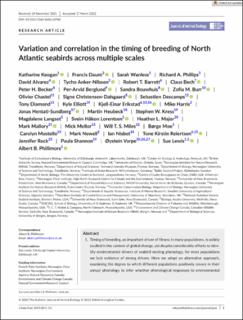Variation and correlation in the timing of breeding of North Atlantic seabirds across multiple scales
Keogan, Katharine; Daunt, Francis; Wanless, Sarah; Phillips, Richard A.; Alvarez, David; Anker-Nilssen, Tycho; Barrett, Robert; Bech, Claus; Becker, Peter H.; Berglund, Per-Arvid; Bouwhuis, Sandra; Burr, Zofia M.; Chastel, Olivier; Christensen-Dalsgaard, S*; Christensen-Dalsgaard, Signe; Descamps, Sebastien; Diamond, Tony; Elliott, Kyle; Erikstad, Kjell E.; Harris, Mike; Hentati-Sundberg, Jonas; Heubeck, Martin; Kress, Stephen W.; Langset, Magdalene; Lorentsen, Svein-Håkon; Major, Heather L.; Mallory, Mark; Mellor, Mick; Miles, Will T.S.; Moe, Børge; Mostello, Carolyn; Newell, Mark; Nisbet, Ian; Reiertsen, Tone Kristin; Rock, Jennifer; Shannon, Paula; Varpe, Øystein; Lewis, Sue; Phillimore, Albert B.
Peer reviewed, Journal article
Published version

Åpne
Permanent lenke
https://hdl.handle.net/11250/3001326Utgivelsesdato
2022Metadata
Vis full innførselSamlinger
- Publikasjoner fra CRIStin - NINA [2364]
- Scientific publications [1392]
Originalversjon
10.1111/1365-2656.13758Sammendrag
1. Timing of breeding, an important driver of fitness in many populations, is widely studied in the context of global change, yet despite considerable efforts to identify environmental drivers of seabird nesting phenology, for most populations we lack evidence of strong drivers. Here we adopt an alternative approach, examining the degree to which different populations positively covary in their annual phenology to infer whether phenological responses to environmental drivers are likely to be (a) shared across species at a range of spatial scales, (b) shared across populations of a species or (c) idiosyncratic to populations. 2. We combined 51 long-term datasets on breeding phenology spanning 50 years from nine seabird species across 29 North Atlantic sites and examined the extent to which different populations share early versus late breeding seasons depending on a hierarchy of spatial scales comprising breeding site, small-scale region, large-scale region and the whole North Atlantic. 3. In about a third of cases, we found laying dates of populations of different species sharing the same breeding site or small-scale breeding region were positively correlated, which is consistent with the hypothesis that they share phenological responses to the same environmental conditions. In comparison, we found no evidence for positive phenological covariation among populations across species aggregated at larger spatial scales. 4. In general, we found little evidence for positive phenological covariation between populations of a single species, and in many instances the inter-year variation specific to a population was substantial, consistent with each population responding idiosyncratically to local environmental conditions. Black-legged kittiwake Rissa tridactyla was the exception, with populations exhibiting positive covariation in laying dates that decayed with the distance between breeding sites, suggesting that populations may be responding to a similar driver. 5. Our approach sheds light on the potential factors that may drive phenology in our study species, thus furthering our understanding of the scales at which different seabirds interact with interannual variation in their environment. We also identify additional systems and phenological questions to which our inferential approach could be applied. breeding time, climate change, macroecology, multispecies, phenology
